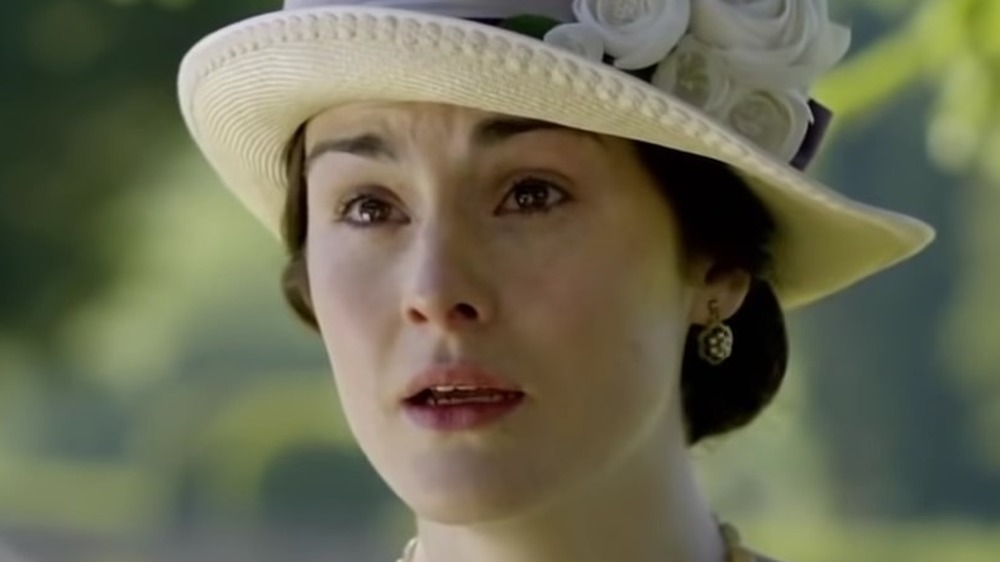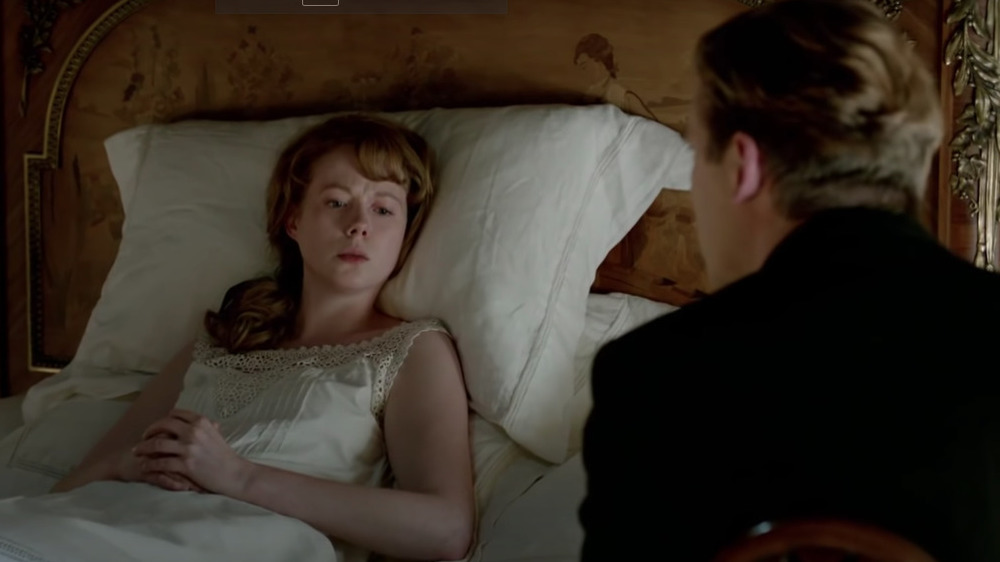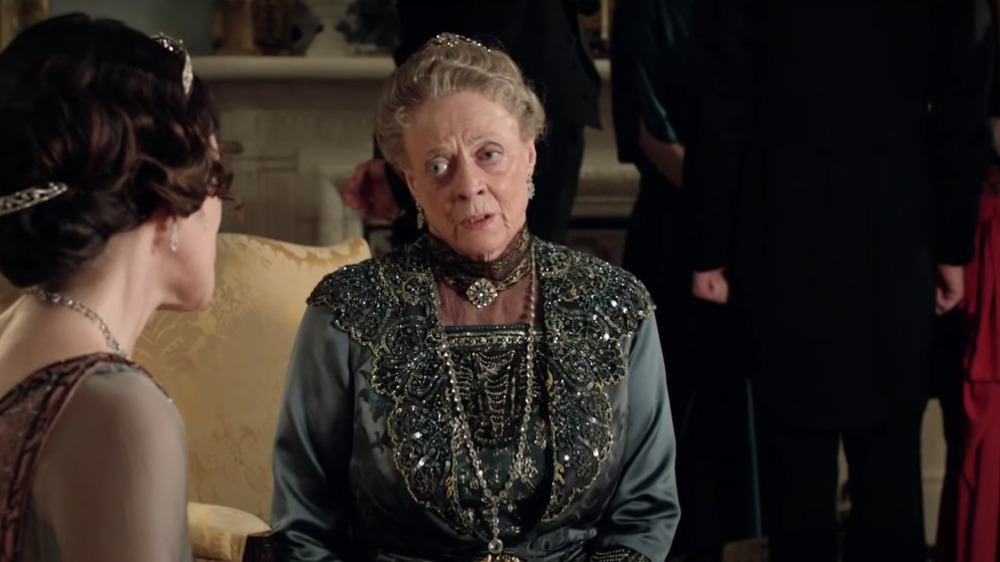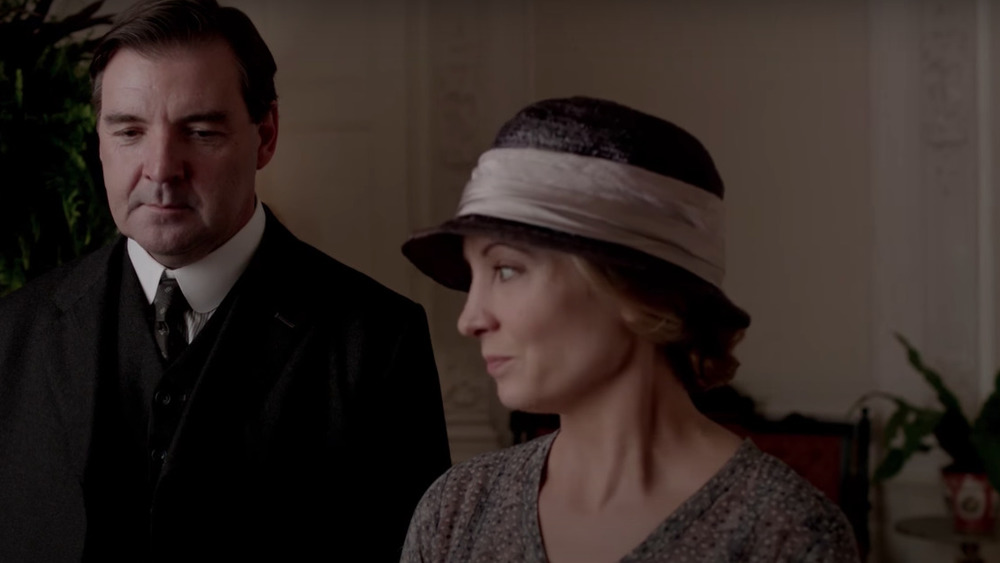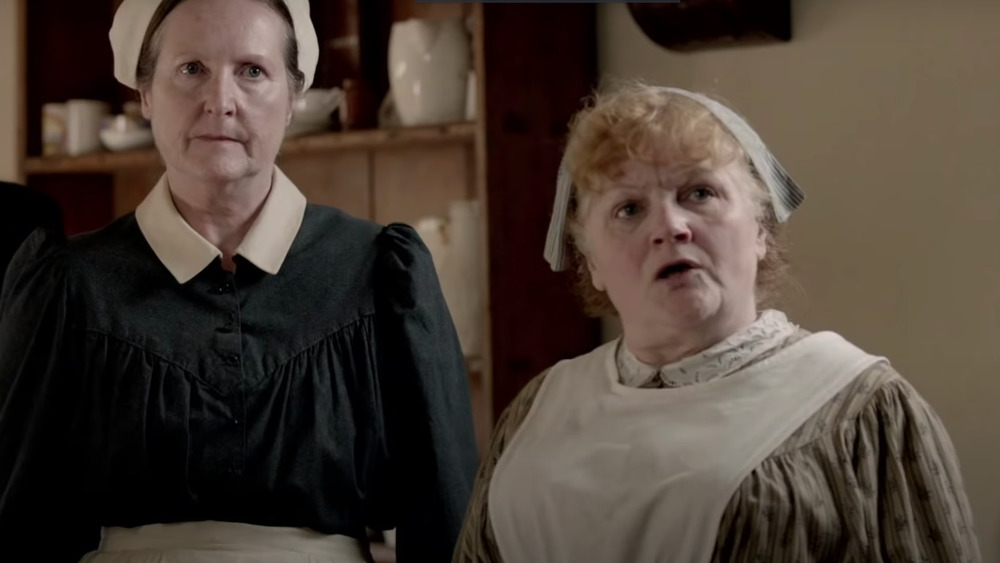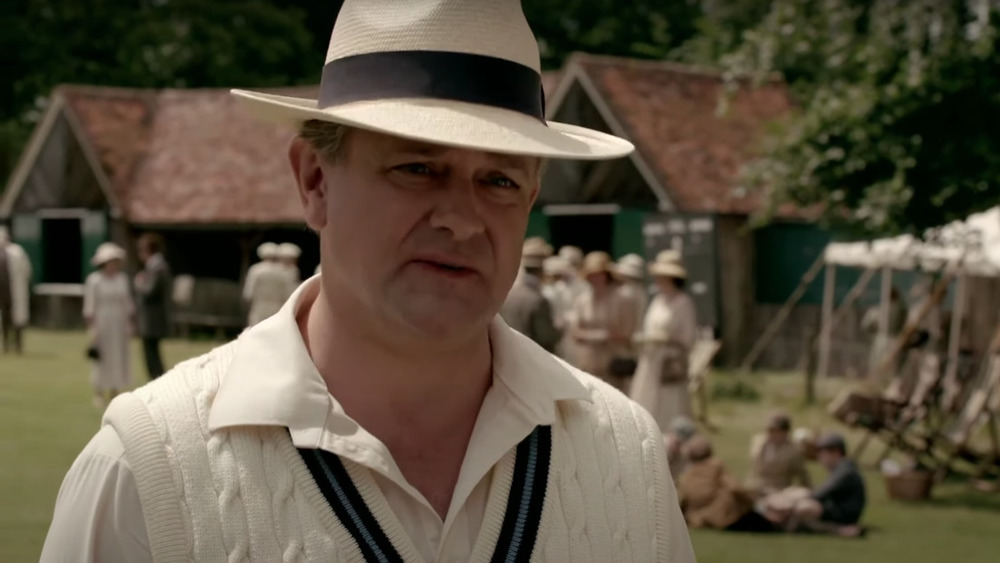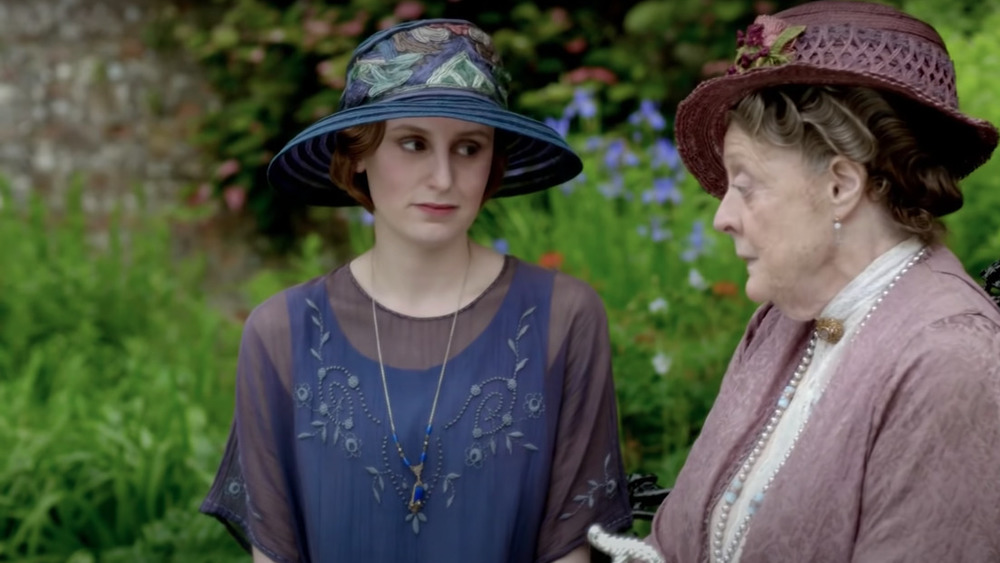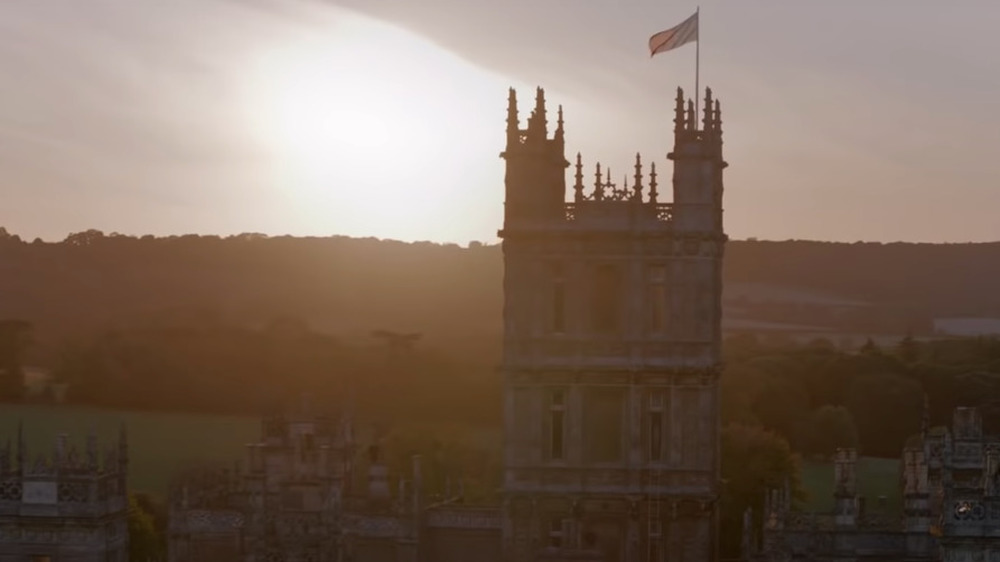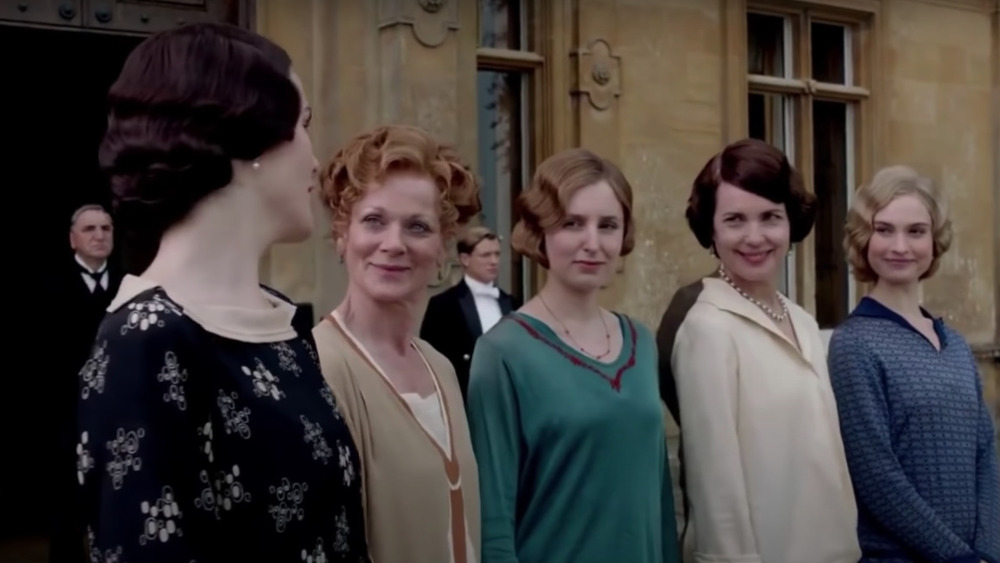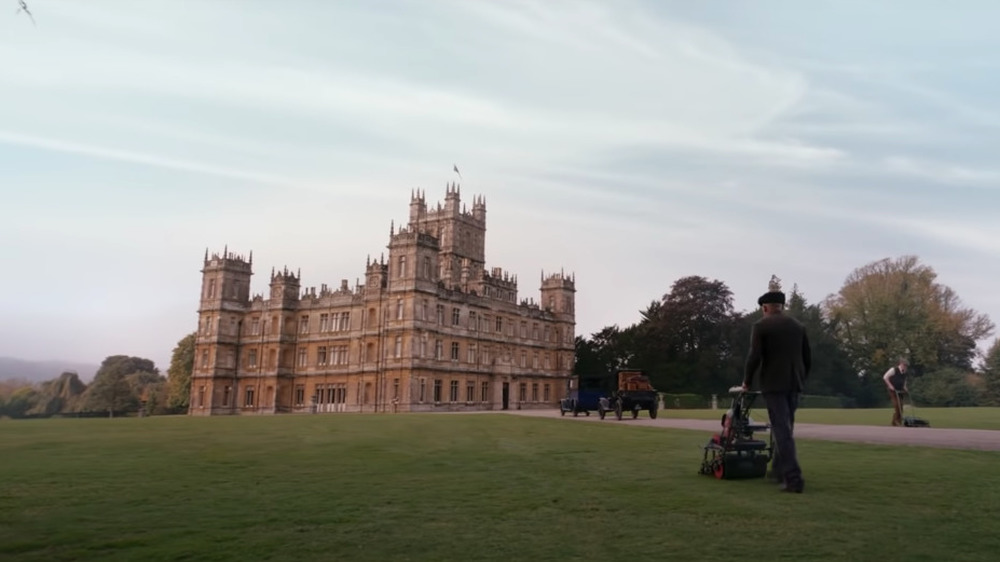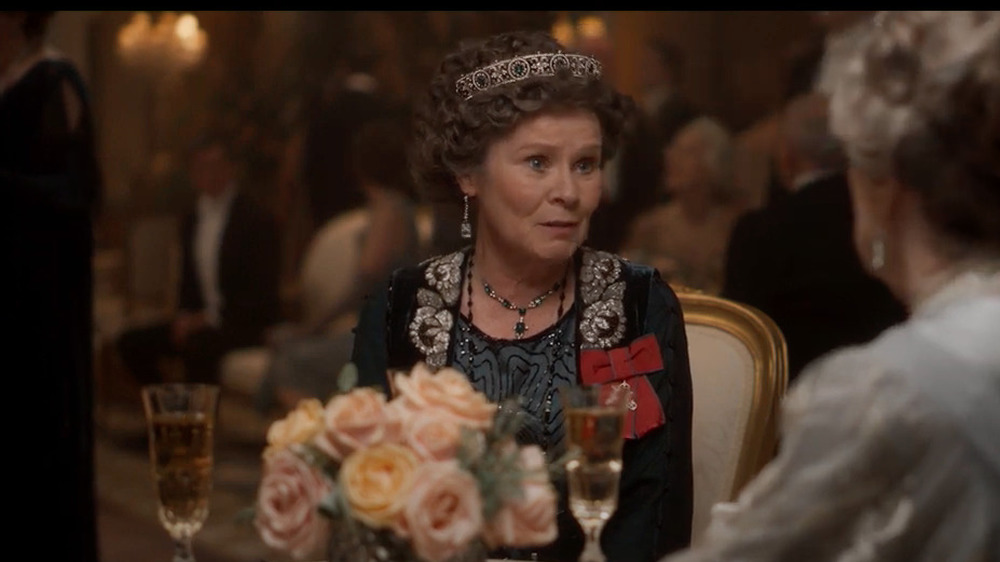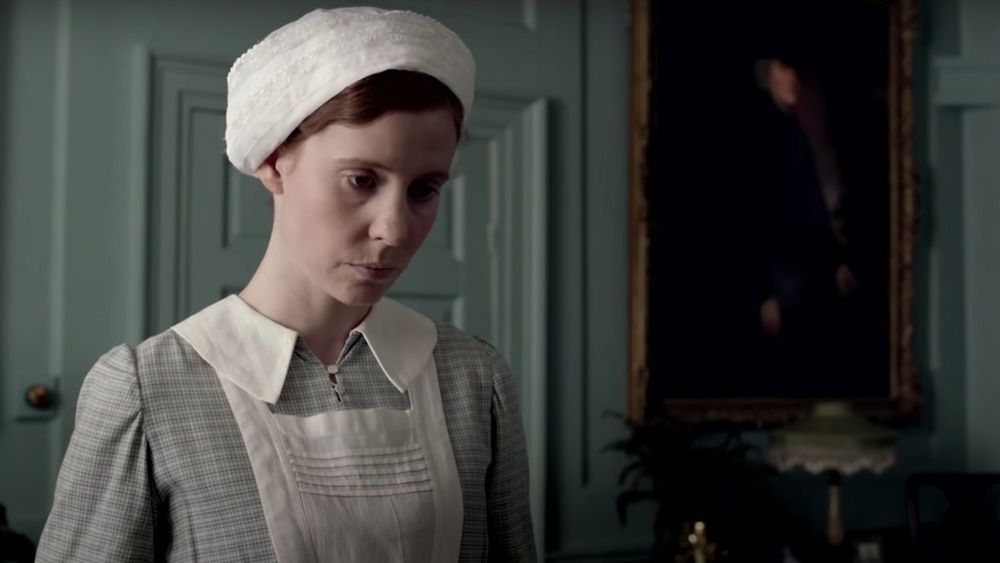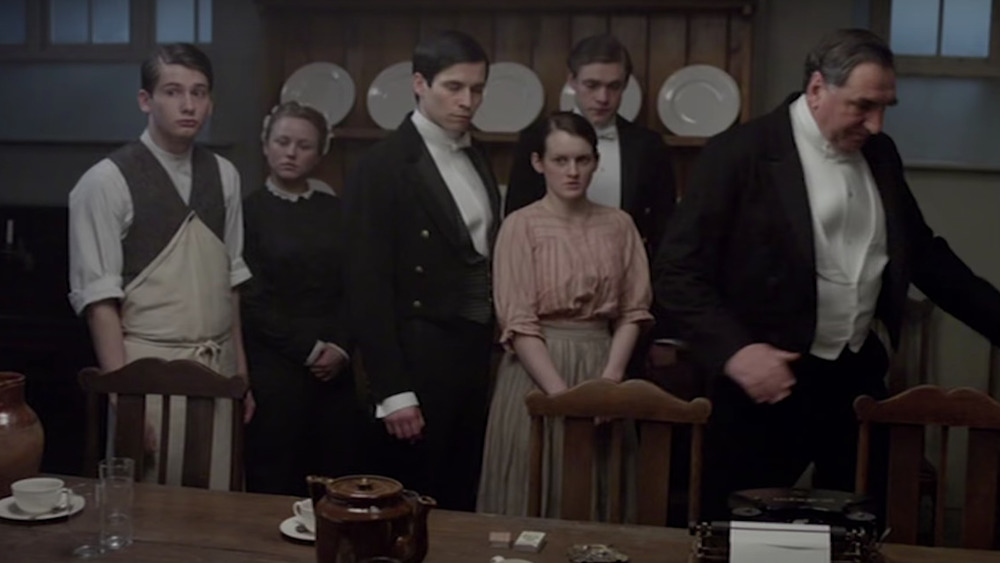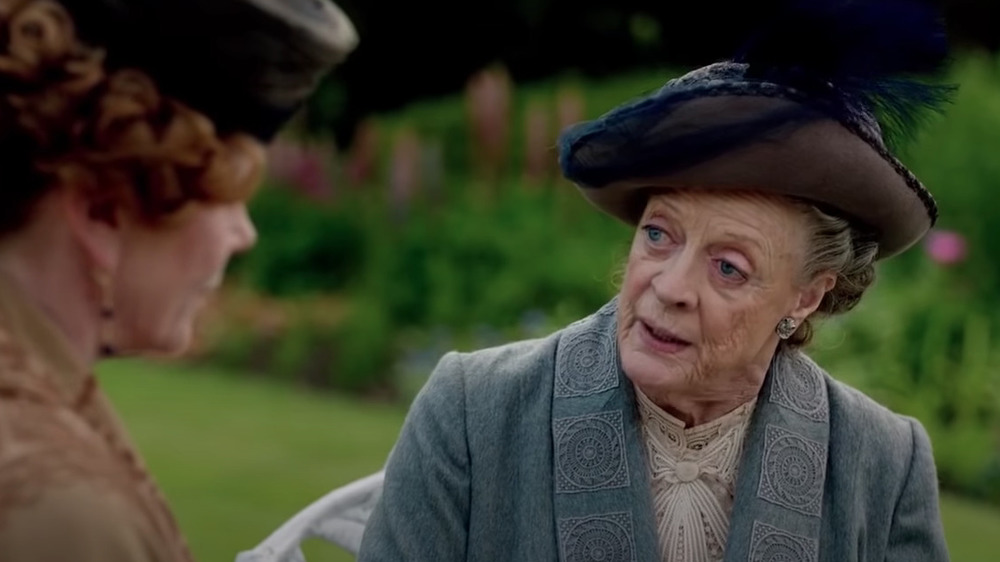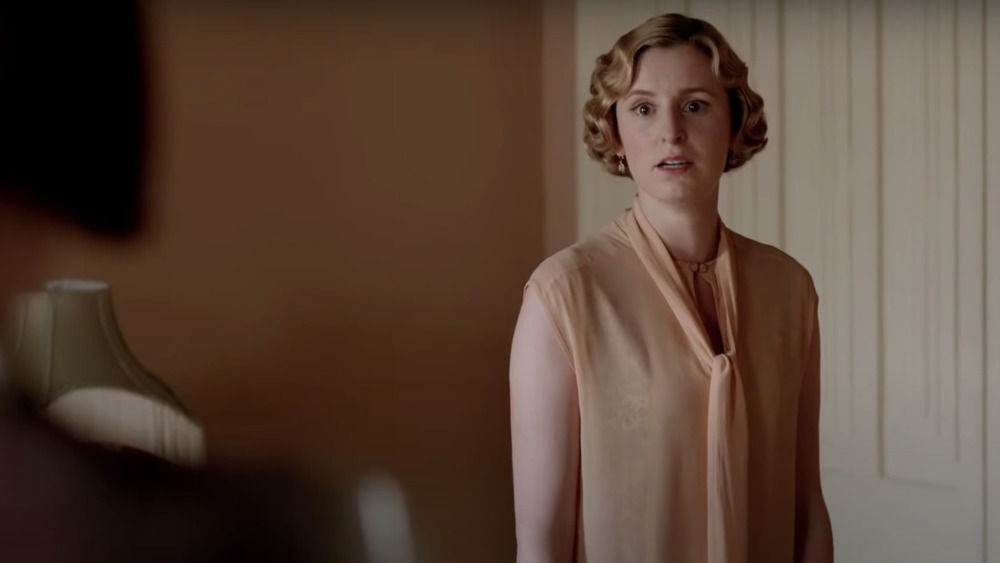Things You Never Noticed In Downton Abbey
No one ever expected Downton Abbey to be the sweeping success that it was. After all, it wasn't the first period drama to come from the BBC to PBS. The show's creator, Julian Fellowes, even confessed on the radio program Desert Island Discs, "I don't fully understand why it did so well" (via RTE). However, from the moment that Downton Abbey hit our screens back in 2010, audiences were hooked. The show became the top PBS drama ever. As Forbes reported, at the height of the series' popularity, it raked in an average weekly audience of up to 13.3 million viewers.
Downton Abbey followed the aristocratic Granthams of Downton Abbey as they navigated the changing social and economic landscape of the twentieth century. With a whole horde of servants scurrying about in Downton's basements, plenty of scandal and drama naturally ensued. In many ways, the show was the perfect mixture of breathtaking period costumes and modern-day soap opera.
Even if you were a massive fan of the show during its heyday — 2010 until its Downton Abbey's cancelation in 2015 – there may be a few things you missed the first time around.
Downton Abbey takes place during a pandemic
In a post-COVID-19 world, it's safe to say that we all now understand what living through a pandemic is like. The virus completely transformed our lives, and we found ourselves sheltering in place through much of 2020, with businesses and schools closing and regulations put in place regarding mask wearing and social distancing.
It may surprise you to learn that Downton Abbey is set during a major pandemic — the Spanish Flu. The flu lasted from 1918 to 1919 — more than 50 million people died around the world, and 228,000 people died just in Britain. It's safe to say that this pandemic was just as devastating as COVID. And yet, in the Downton Abbey universe, it's pretty easy to miss the pandemic altogether. In fact, it only lasts for half an episode or so! As Vanity Fair joked in its review of the episode, the Spanish Flu represented on the show is "a rare 20-minute illness whose specialty is romantic devastation."
It's pretty weird to watch this fictionalized version of the 1919 pandemic — where are the masks? Aren't they all terrified of leaving the house? No wonder we didn't really notice the pandemic the first time.
Downton Abbey, the TV show, is all about morality, but the film is not
One of the things that makes Downton Abbey so unusual is its focus on morality. As The Washington Post pointed out, the show operates in a world of intrinsic ethical justice. When characters do wrong, they are punished; when they do good, they are rewarded. In fact, the Post even suggested, "The unfailing karma that infuses the show is every bit as intoxicating as the decor and decorum."
However, when the long-awaited film version of the show finally came to cinemas in 2019, this moral justness was conspicuously missing from the Downton universe. If you felt that the film had a slightly different feel from the series, but you couldn't put your finger on why, it may have been that karma no longer seemed to be at play. In fact, in the film, the servants plot to get rid of the royal servants — and not only are they not punished, they are regarded as heroes! No wonder the film feels different compared to the show.
This infamous Downton Abbey scene is weirdly all about the woman's husband
In the fourth season of Downton Abbey, one of the show's best-loved characters, Anna, is brutally raped, resulting in a hugely upsetting scene that triggered angry reactions from many fans (via BuzzFeed). However, what you may not have noticed is the problematic aftermath of the horrific scene. While the show clearly tried to be sensitive with the subject matter, when rewatching the scene and its aftermath in a post #MeToo world, a few things jump out that didn't at the time.
For one thing, the show almost instantly puts all of its focus on Anna's husband and how the event affected him. In fact, one reviewer in The Guardian noted that the rape is just a "device intended to continue the narrative arc of her husband as a tragic hero." Needless to say, it's pretty problematic to throw in a traumatic rape scene just to make another man look good. While this may have struck you as a little problematic when the episode first aired, it's impossible to ignore now.
Downton Abbey doesn't sit right in today's political and economic climate
When Downton Abbey first aired, the world looked very different than it does today. After all, it was a pre-Trump, pre-Brexit world. As Gregory Kosc and Kallie Koscone of the History News Network of George Washington University noted, the show has a sour feel in today's political climate. These days, the inequalities in our society are all too clear. In fact, in a post-COVID world, inequalities are even more evident than ever. The pandemic has shed light on the class system that is still prevalent in America — those from low-income areas and households have been more at risk of contracting the virus and losing work.
Downton Abbey puts a pair of rose-tinted glasses on the class system, with the servants happily existing in their subservient roles, rarely attempting to rise above their circumstances. In a world where the harsh realities of class inequality are all too clear, watching Downton Abbey suddenly feels a little uncomfortable.
Downton Abbey's Lord Grantham is basically the worst
On a first watch of Downton Abbey, the patriarch of the Grantham family doesn't seem too bad. Sure, he's a little stuck in his ways and he makes some mistakes, but, overall, he seems to be a good guy. In fact, one blog even named him its ninth favorite character!
However, rewatching Downton Abbey, we begin to realize that Lord Grantham is actually pretty problematic. It may be that after #MeToo, we've all become a little more aware of how over-privileged white men can have a tendency to bulldoze and delay necessary change. As KQED pointed out, this is exactly Lord Grantham's problem. For one thing, he's terrible at managing the family's money — he makes a terrible investment with his wife's money, without asking his wife. He also ignores a medical professional who says his daughter should give birth in a hospital — she passes away. He even starts an affair with one of his maids in a moment of mid-life crisis. We never noticed it before, but Lord Grantham is kind of the worst.
In a post-COVID world, Downton Abbey's domesticity is refreshing and relatable
Since the COVID-19 pandemic hit in 2020, we've all spent a lot more time at home. In fact, many of us are even working full-time from our homes. One major shift from the pandemic is a new interest in the simple pleasures of domesticity. Many of us have developed a newfound love of interior design, while others have gotten into cooking. Downton Abbey originally aired in the pre-pandemic world, so, for most of us, its domestic focus didn't really feel particularly relatable.
However, these days, the charming domesticity of Downton Abbey feels a lot more enjoyable and relatable. And, as The Washington Post noted, it's pretty rare for a big budget series to exist entirely in the home. It's definitely nice to see strong women embracing domesticity as part of their lives — and these days, when we've all been forced to do the same, it's a welcome relief.
One room in Downton Abbey is shown only in the first episode
Here's one thing you probably never noticed while watching Downton Abbey — we never find out what's in that great big tower! Sure, we see the bedrooms and basements and even the upper floors where the servants sleep — but what is in that giant tower? Well, it turns out, we do actually get one glimpse into the mysterious tower — but you may have missed it, as it occurs in the very first episode.
As BuzzFeed noted, the one scene that takes place in the tower is actually the luggage room scene. BuzzFeed even spoke to the show's production designer, Donal Woods, about why the tower only appears once. Apparently, the show's crew weren't sure where to film the scene. Woods asked the house's manager, Lady Carnarvon, for a suitable room. "She said, 'Come and look at mine!'" Apparently, the real luggage room of the estate is actually in the tower. "It's a stunningly beautiful room," Woods recalled, "for what effectively keeps luggage." However, it turns out, the tower isn't exactly safe. "There's liability problems. ... We couldn't go up there [now]," Woods explained. No wonder we only saw the room once!
Each Downton Abbey character has their own distinct color palette
We all spent plenty of time ogling the gorgeous period costumes in Downton Abbey. But what you may not have realized is that each character has their own specific look. In an interview with Vogue, the show's costume designer, Anna Robins, explained some hidden secrets about the costumes that most viewers probably never picked up on.
For Lady Edith, the color palette was filled with "autumnal colors" in Season 5 because her life was "difficult" at that point. However, when she enters the literary world, she "blossomed as a character," as Robbins put it, so her color scheme becomes filled with spring colors, with fun prints and experimental designs.
As for Lady Mary, her look is a total contrast. "Her wardrobe is quite linear and androgynous," Robbins said. As for her color scheme, it's filled with "deep burgundies and navy blues that would never suit the other characters." We love learning about these little touches in the costume design that highlight the personalities of each character!
The Downton Abbey estate may look a little familiar
Ever since Downton Abbey first aired, the house has become iconic. After all, the show is named after the house itself, and it appears on just about every poster and in every trailer. However, you may be surprised to learn that the real estate, Highclere Castle, has actually been used for a few other major productions.
In 2006, the house made a surprising appearance in John Legend's music video for "Heaven." The house was also used for the 1987 version of The Secret Garden. You can also spot the famous house in the Hugh Laurie and Stephen Fry '90s show Jeeves and Wooster. In 2002, the estate was featured in the Heath Ledger and Kate Hudson film The Four Feathers. And, back in 1982, Downton Abbey's own Maggie Smith visited the Castle to film The Missionary. Clearly, this stunning stately home is very used to hosting film crews!
You may have missed all of the new rooms in the Downton Abbey movie
There's no denying that Downton Abbey is a massive home. Throughout the six seasons of the show, we got to see a wide range of drawing rooms, hallways, bedrooms, and servant rooms. However, you may not have spotted all of the brand-new rooms that appeared in the film.
As Donal Woods, the production designer of the film, told Architectural Digest, the crew actually added a bunch of new sets for the movie. "We just wanted to up the level to make it more lavish, to give the audience something more and make it richer and more opulent," he explained.
First of all, the set designers added a brand-new bedroom for Imelda Staunton's character, "which we clad in real burgundy silk damask from India on the walls," Woods said. The crew also created sets for the wine cellar, the silver room, the servers, and added additional servants' quarters and sets for Mr. Carson and Mrs. Hughes' cottage. Wow, they certainly went to town! As Gina Cromwell, the film's set decorator told Architectural Digest proudly, "It was massively satisfying to be able to create sets that we didn't have the space to do before."
The Downton Abbey film contains a blink-and-you'll-miss-it Easter egg
Another thing that may have escaped your notice in the Downton Abbey film is a wonderful little Easter egg for true fans of the show. As BT noted, in Season 3 of the show, there's a brief moment when Ethel, a housemaid who becomes pregnant, explains that she had a "nasty encounter" when she went to visit the greengrocer, Mr. Bakewell. His wife, Mrs. Bakewell, refused to serve her. "Her husband did but it wasn't very nice," Ethel says.
While we never get to meet this Mr. Bakewell in the show, years later, he appears in the film. In fact, he's actually played by Mark Addy, whom you may recognize as the actor who played Robert Baratheon in Game of Thrones. It's so cool to see how thorough the writers of Downton Abbey were in including this character from Season 3 in the film!
Downton Abbey is definitely not historically accurate even if it feels like it is
For most viewers, Downton Abbey probably feels incredibly accurate. With its precise script, its incredible costumes, and its portrayal of upstairs-downstairs life, it often feels like a real glimpse into the past. However, only the most astute viewers will notice that a lot of the show is actually historically inaccurate.
One of these eagle-eyed viewers is none other than Her Majesty Queen Elizabeth II! As Brian Hoey, author of At Home With The Queen, told People, the queen apparently spotted an officer from the First World War wearing medals from the Second World War. Wow, we have to say, we're impressed!
Nicoletta Gullace, a historian from the University of New Hampshire, actually spotted a few more mistakes that were actually made on purpose. As she explained, "Life was hard and gritty in the early [1900s]. So the show's producers created a safe and more palatable experience to satisfy today's viewer by airbrushing over some of the ugliness including severe poverty, human rights abuses, bankruptcy, rampant sexism, and just how dirty it was to live during that period" (via Phys.org).
None of the Downton characters' ages make any sense
Downton Abbey actually covers a couple of decades. Season 1, which aired in 2010, was set in 1912, while the final season, which aired in 2015, was set in 1925. Some simple math will tell you that the ages of the actors do not match the ages of the characters. In 2015, the actors were all playing characters that had aged 13 years, while the Downton Abbey actors themselves had only aged five years. Either these characters are blessed with eternal youth (and great skincare routines), or something doesn't add up!
A few viewers began to question the age problem, as the Daily Mail noted. One wrote, "Does the Earl of Grantham use Grecian 2000 or something? Why is the Dowager still alive and sharp-witted and [why do] the girls/boys still have the face of youth?"
Even Maggie Smith, who played the Dowager, noted that the ages really don't make sense. In an interview on The Graham Norton Show, she joked about the film, "Honestly, she was about, by the time I finished, she must have been 110. It couldn't go on and on and on... It didn't make sense!"
The pattern of women fighting is pretty dated, even for a period drama like Downton Abbey
One thing that most viewers probably simply accepted while watching Downton Abbey was the show's bitter female rivalries. However, on a second watch, this aspect of the show does come across as a little dated and, to put it bluntly, a little sexist. As one viewer pointed out on 3 Quarks Daily, "There are three pairs of women presented as [b*****s] who connive against each other at every opportunity: O'Brien and Anna, Mary and Edith, Isobel and the Dowager Countess."
It's a pretty good point — what's with all of these horrible female feuds? While Downton Abbey does have some fascinating, complex female characters, this tired, cliched plot device does come across as a little out of touch and unrealistic. We have to admit — it would have been great to see some strong female bonds on this show!
